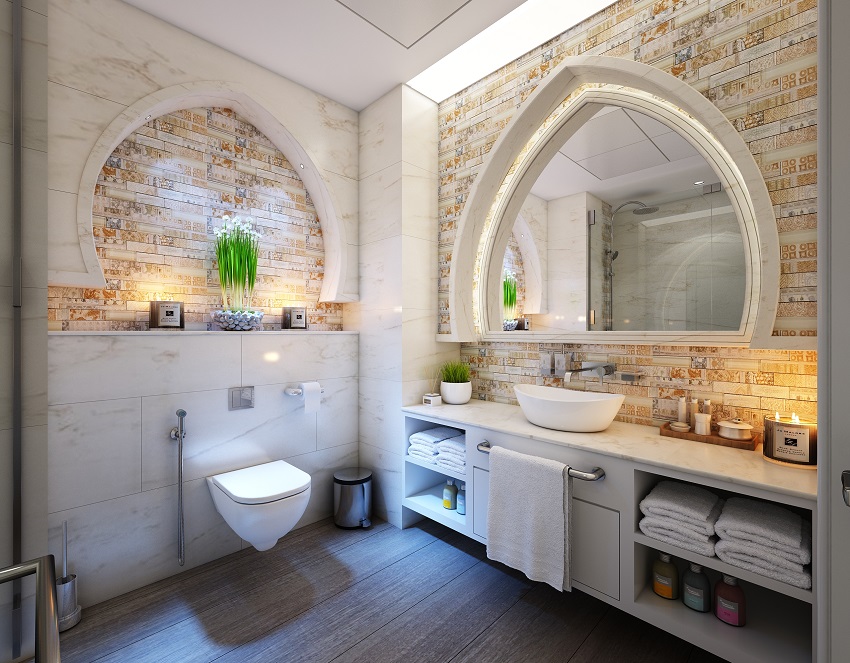Tiles are the traditional bathroom flooring option. They are often the first image you think of when thinking of bathroom flooring. But tiles along with real wood and stone, do not come cheap. Additionally, installing these types of flooring can be tricky and costly, along with the ongoing maintenance. Looking at vinyl flooring as a more affordable alternative would be worthwhile. Especially as there is sure to be a design to suit your needs, that’s easy to fit and look after.
Why Vinyl?
Vinyl has always been a great option for bathroom flooring. It continues to be a go to choice for those who don’t wish to go down the ceramic route. Unlike ceramic, it has a comfortable feel under the foot. This has earnt it the name ‘cushion flooring’. Vinyl can bring comfort and warmth to your home, working well with underfloor heating. It is a great option for the extra comfort it brings to your underfoot.
But the main reason why vinyl is our top choice, is the products durability. Vinyl flooring is extremely hard-wearing, water and stain resistant, whilst being capable of enduring heavy footfall. It’s also anti-slip, adding to its practicality and resistant properties make it ideal for your bathroom.
Easy Maintenance
Easy to maintain and clean, it will continue looking great for years to come. Coupled with the style choices available, vinyl is the perfect flooring solution. Especially if you’re looking for fuss-free interior style. Vinyl is very much a do-it-yourself job. Furthermore, it can easily be installed and you do not require any heavy or complicated building materials.
Vinyl flooring comes in an array of designs and patterns, enabling you to realistically mimic any flooring style. This range of choice gives you the freedom to get as creative in your home with colour and pattern as you want. Anything from wood to stone, vinyl allows you to have your desired style in your bathroom.
Types of vinyl
There are a few types of vinyl to choose, sheet vinyl flooring, plank vinyl, and tile vinyl. Sheet vinyl is the best option for a bathroom as it is ideal for areas where extreme amounts of water are expected. But other forms are just as effective when fitted correctly.
Plank vinyl flooring is used to help create the illusion of real wooden flooring planks. A popular alternative to real wood flooring, vinyl flooring is cheaper, and of course quicker to fit than real wood.
Installing Vinyl
However, it is important that these two options are laid well, as if the seams of the flooring are poorly laid and have gaps, it can leave room for water to get in and cause damage. Sheet vinyl can have no seams in a small bathroom when laid well.
Tile vinyl flooring is designed to mimic the repeat tile pattern of a natural stone or slate floor. Large square tiles are used to create a unique and authentic surface, making them an ideal cheaper alternative to the real deal.
Furthermore, the beauty of vinyl tiles, is should you somehow manage to damage one of these incredibly durable tiles, that individual tile can be replaced. Perfectly hassle free, with no need to pull the whole floor up.
Different Types Of Vinyl Tile
With tile vinyl, there are three main types which differ in the way that they are fitted. There are dry back vinyl tiles, which require adhesive to be applied to the sub-floor, and in contrast there are self-adhesive vinyl tiles, which already have the adhesive on the backing of each tile. Alternatively, there are click vinyl tiles, which use an innovative click system of fitting the tiles together easily, creating a floating floor surface.
Finally with vinyl, there’s no need to sacrifice style for practicality, as with vinyl tiles you really can have it all. The variety of designs, colours and finishes of vinyl, will have you spoilt for choice. So, bring out your indulgent side with luxury vinyl flooring.

